Attached files
| file | filename |
|---|---|
| 8-K - CURRENT REPORT - Air Transport Services Group, Inc. | a2012form8kcoverq1earnings.htm |
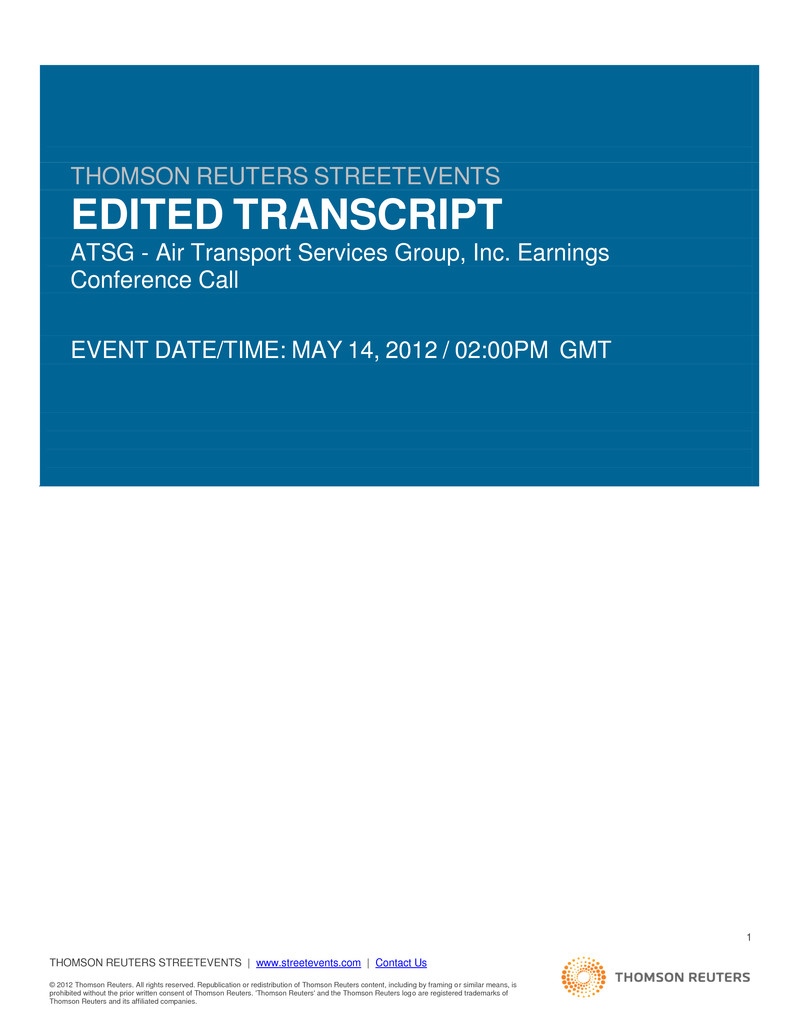
1 THOMSON REUTERS STREETEVENTS | www.streetevents.com | Contact Us © 2012 Thomson Reuters. All rights reserved. Republication or redistribution of Thomson Reuters content, including by framing or similar means, is prohibited without the prior written consent of Thomson Reuters. 'Thomson Reuters' and the Thomson Reuters logo are registered trademarks of Thomson Reuters and its affiliated companies. THOMSON REUTERS STREETEVENTS EDITED TRANSCRIPT ATSG - Air Transport Services Group, Inc. Earnings Conference Call EVENT DATE/TIME: MAY 14, 2012 / 02:00PM GMT
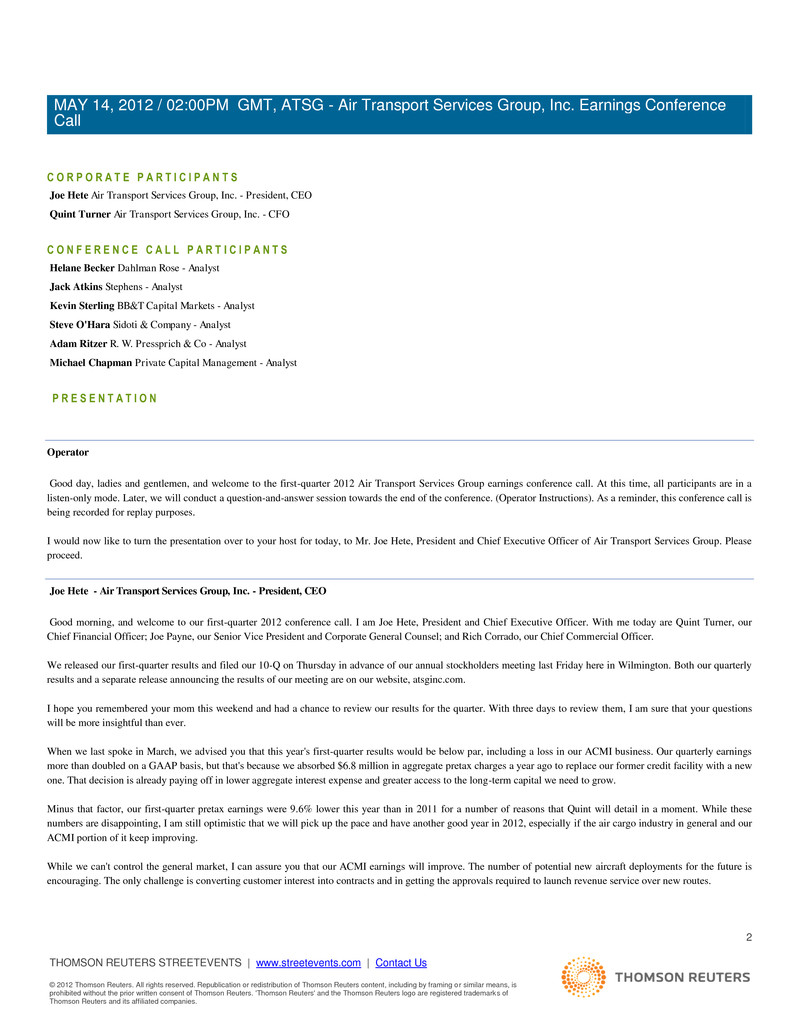
MAY 14, 2012 / 02:00PM GMT, ATSG - Air Transport Services Group, Inc. Earnings Conference Call 2 THOMSON REUTERS STREETEVENTS | www.streetevents.com | Contact Us © 2012 Thomson Reuters. All rights reserved. Republication or redistribution of Thomson Reuters content, including by framing or similar means, is prohibited without the prior written consent of Thomson Reuters. 'Thomson Reuters' and the Thomson Reuters logo are registered trademarks of Thomson Reuters and its affiliated companies. C O R P O R A T E P A R T I C I P A N T S Joe Hete Air Transport Services Group, Inc. - President, CEO Quint Turner Air Transport Services Group, Inc. - CFO C O N F E R E N C E C A L L P A R T I C I P A N T S Helane Becker Dahlman Rose - Analyst Jack Atkins Stephens - Analyst Kevin Sterling BB&T Capital Markets - Analyst Steve O'Hara Sidoti & Company - Analyst Adam Ritzer R. W. Pressprich & Co - Analyst Michael Chapman Private Capital Management - Analyst P R E S E N T A T I O N Operator Good day, ladies and gentlemen, and welcome to the first-quarter 2012 Air Transport Services Group earnings conference call. At this time, all participants are in a listen-only mode. Later, we will conduct a question-and-answer session towards the end of the conference. (Operator Instructions). As a reminder, this conference call is being recorded for replay purposes. I would now like to turn the presentation over to your host for today, to Mr. Joe Hete, President and Chief Executive Officer of Air Transport Services Group. Please proceed. Joe Hete - Air Transport Services Group, Inc. - President, CEO Good morning, and welcome to our first-quarter 2012 conference call. I am Joe Hete, President and Chief Executive Officer. With me today are Quint Turner, our Chief Financial Officer; Joe Payne, our Senior Vice President and Corporate General Counsel; and Rich Corrado, our Chief Commercial Officer. We released our first-quarter results and filed our 10-Q on Thursday in advance of our annual stockholders meeting last Friday here in Wilmington. Both our quarterly results and a separate release announcing the results of our meeting are on our website, atsginc.com. I hope you remembered your mom this weekend and had a chance to review our results for the quarter. With three days to review them, I am sure that your questions will be more insightful than ever. When we last spoke in March, we advised you that this year's first-quarter results would be below par, including a loss in our ACMI business. Our quarterly earnings more than doubled on a GAAP basis, but that's because we absorbed $6.8 million in aggregate pretax charges a year ago to replace our former credit facility with a new one. That decision is already paying off in lower aggregate interest expense and greater access to the long-term capital we need to grow. Minus that factor, our first-quarter pretax earnings were 9.6% lower this year than in 2011 for a number of reasons that Quint will detail in a moment. While these numbers are disappointing, I am still optimistic that we will pick up the pace and have another good year in 2012, especially if the air cargo industry in general and our ACMI portion of it keep improving. While we can't control the general market, I can assure you that our ACMI earnings will improve. The number of potential new aircraft deployments for the future is encouraging. The only challenge is converting customer interest into contracts and in getting the approvals required to launch revenue service over new routes.
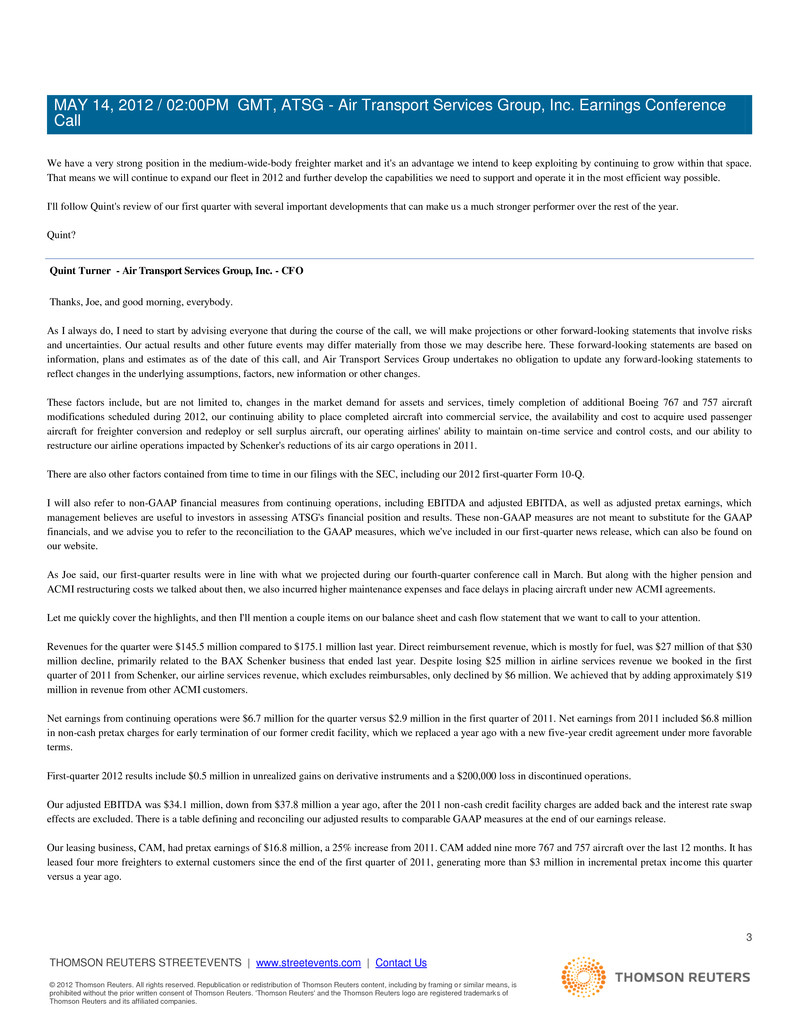
MAY 14, 2012 / 02:00PM GMT, ATSG - Air Transport Services Group, Inc. Earnings Conference Call 3 THOMSON REUTERS STREETEVENTS | www.streetevents.com | Contact Us © 2012 Thomson Reuters. All rights reserved. Republication or redistribution of Thomson Reuters content, including by framing or similar means, is prohibited without the prior written consent of Thomson Reuters. 'Thomson Reuters' and the Thomson Reuters logo are registered trademarks of Thomson Reuters and its affiliated companies. We have a very strong position in the medium-wide-body freighter market and it's an advantage we intend to keep exploiting by continuing to grow within that space. That means we will continue to expand our fleet in 2012 and further develop the capabilities we need to support and operate it in the most efficient way possible. I'll follow Quint's review of our first quarter with several important developments that can make us a much stronger performer over the rest of the year. Quint? Quint Turner - Air Transport Services Group, Inc. - CFO Thanks, Joe, and good morning, everybody. As I always do, I need to start by advising everyone that during the course of the call, we will make projections or other forward-looking statements that involve risks and uncertainties. Our actual results and other future events may differ materially from those we may describe here. These forward-looking statements are based on information, plans and estimates as of the date of this call, and Air Transport Services Group undertakes no obligation to update any forward-looking statements to reflect changes in the underlying assumptions, factors, new information or other changes. These factors include, but are not limited to, changes in the market demand for assets and services, timely completion of additional Boeing 767 and 757 aircraft modifications scheduled during 2012, our continuing ability to place completed aircraft into commercial service, the availability and cost to acquire used passenger aircraft for freighter conversion and redeploy or sell surplus aircraft, our operating airlines' ability to maintain on-time service and control costs, and our ability to restructure our airline operations impacted by Schenker's reductions of its air cargo operations in 2011. There are also other factors contained from time to time in our filings with the SEC, including our 2012 first-quarter Form 10-Q. I will also refer to non-GAAP financial measures from continuing operations, including EBITDA and adjusted EBITDA, as well as adjusted pretax earnings, which management believes are useful to investors in assessing ATSG's financial position and results. These non-GAAP measures are not meant to substitute for the GAAP financials, and we advise you to refer to the reconciliation to the GAAP measures, which we've included in our first-quarter news release, which can also be found on our website. As Joe said, our first-quarter results were in line with what we projected during our fourth-quarter conference call in March. But along with the higher pension and ACMI restructuring costs we talked about then, we also incurred higher maintenance expenses and face delays in placing aircraft under new ACMI agreements. Let me quickly cover the highlights, and then I'll mention a couple items on our balance sheet and cash flow statement that we want to call to your attention. Revenues for the quarter were $145.5 million compared to $175.1 million last year. Direct reimbursement revenue, which is mostly for fuel, was $27 million of that $30 million decline, primarily related to the BAX Schenker business that ended last year. Despite losing $25 million in airline services revenue we booked in the first quarter of 2011 from Schenker, our airline services revenue, which excludes reimbursables, only declined by $6 million. We achieved that by adding approximately $19 million in revenue from other ACMI customers. Net earnings from continuing operations were $6.7 million for the quarter versus $2.9 million in the first quarter of 2011. Net earnings from 2011 included $6.8 million in non-cash pretax charges for early termination of our former credit facility, which we replaced a year ago with a new five-year credit agreement under more favorable terms. First-quarter 2012 results include $0.5 million in unrealized gains on derivative instruments and a $200,000 loss in discontinued operations. Our adjusted EBITDA was $34.1 million, down from $37.8 million a year ago, after the 2011 non-cash credit facility charges are added back and the interest rate swap effects are excluded. There is a table defining and reconciling our adjusted results to comparable GAAP measures at the end of our earnings release. Our leasing business, CAM, had pretax earnings of $16.8 million, a 25% increase from 2011. CAM added nine more 767 and 757 aircraft over the last 12 months. It has leased four more freighters to external customers since the end of the first quarter of 2011, generating more than $3 million in incremental pretax income this quarter versus a year ago.
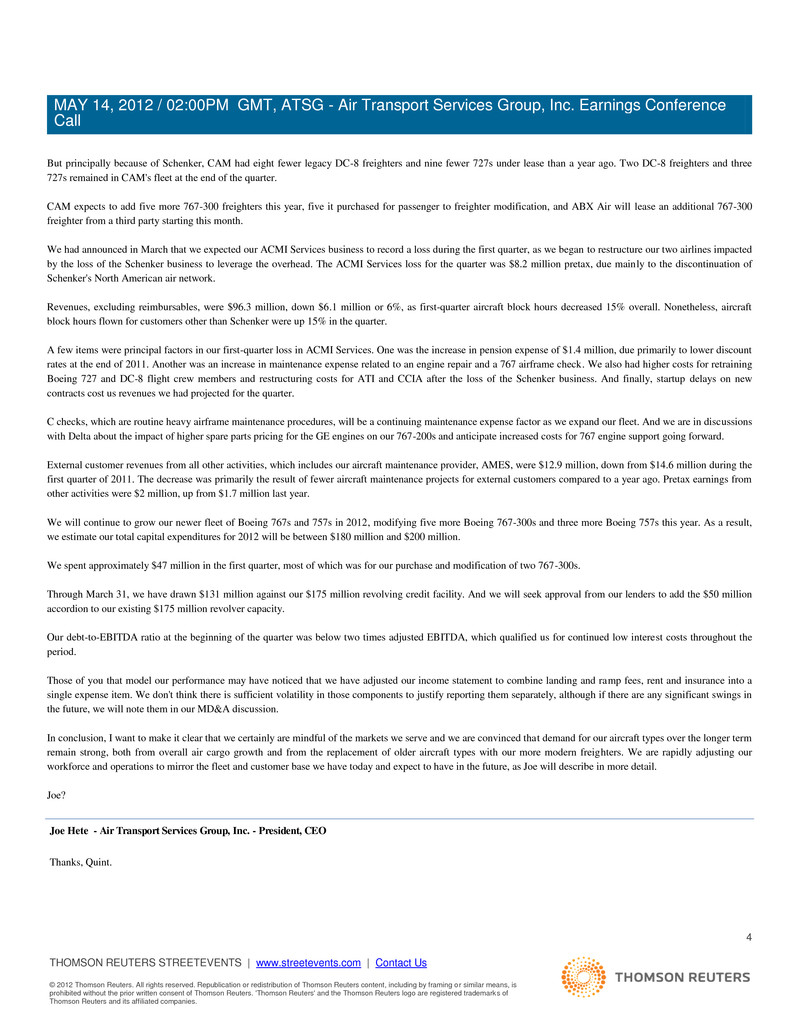
MAY 14, 2012 / 02:00PM GMT, ATSG - Air Transport Services Group, Inc. Earnings Conference Call 4 THOMSON REUTERS STREETEVENTS | www.streetevents.com | Contact Us © 2012 Thomson Reuters. All rights reserved. Republication or redistribution of Thomson Reuters content, including by framing or similar means, is prohibited without the prior written consent of Thomson Reuters. 'Thomson Reuters' and the Thomson Reuters logo are registered trademarks of Thomson Reuters and its affiliated companies. But principally because of Schenker, CAM had eight fewer legacy DC-8 freighters and nine fewer 727s under lease than a year ago. Two DC-8 freighters and three 727s remained in CAM's fleet at the end of the quarter. CAM expects to add five more 767-300 freighters this year, five it purchased for passenger to freighter modification, and ABX Air will lease an additional 767-300 freighter from a third party starting this month. We had announced in March that we expected our ACMI Services business to record a loss during the first quarter, as we began to restructure our two airlines impacted by the loss of the Schenker business to leverage the overhead. The ACMI Services loss for the quarter was $8.2 million pretax, due mainly to the discontinuation of Schenker's North American air network. Revenues, excluding reimbursables, were $96.3 million, down $6.1 million or 6%, as first-quarter aircraft block hours decreased 15% overall. Nonetheless, aircraft block hours flown for customers other than Schenker were up 15% in the quarter. A few items were principal factors in our first-quarter loss in ACMI Services. One was the increase in pension expense of $1.4 million, due primarily to lower discount rates at the end of 2011. Another was an increase in maintenance expense related to an engine repair and a 767 airframe check. We also had higher costs for retraining Boeing 727 and DC-8 flight crew members and restructuring costs for ATI and CCIA after the loss of the Schenker business. And finally, startup delays on new contracts cost us revenues we had projected for the quarter. C checks, which are routine heavy airframe maintenance procedures, will be a continuing maintenance expense factor as we expand our fleet. And we are in discussions with Delta about the impact of higher spare parts pricing for the GE engines on our 767-200s and anticipate increased costs for 767 engine support going forward. External customer revenues from all other activities, which includes our aircraft maintenance provider, AMES, were $12.9 million, down from $14.6 million during the first quarter of 2011. The decrease was primarily the result of fewer aircraft maintenance projects for external customers compared to a year ago. Pretax earnings from other activities were $2 million, up from $1.7 million last year. We will continue to grow our newer fleet of Boeing 767s and 757s in 2012, modifying five more Boeing 767-300s and three more Boeing 757s this year. As a result, we estimate our total capital expenditures for 2012 will be between $180 million and $200 million. We spent approximately $47 million in the first quarter, most of which was for our purchase and modification of two 767-300s. Through March 31, we have drawn $131 million against our $175 million revolving credit facility. And we will seek approval from our lenders to add the $50 million accordion to our existing $175 million revolver capacity. Our debt-to-EBITDA ratio at the beginning of the quarter was below two times adjusted EBITDA, which qualified us for continued low interest costs throughout the period. Those of you that model our performance may have noticed that we have adjusted our income statement to combine landing and ramp fees, rent and insurance into a single expense item. We don't think there is sufficient volatility in those components to justify reporting them separately, although if there are any significant swings in the future, we will note them in our MD&A discussion. In conclusion, I want to make it clear that we certainly are mindful of the markets we serve and we are convinced that demand for our aircraft types over the longer term remain strong, both from overall air cargo growth and from the replacement of older aircraft types with our more modern freighters. We are rapidly adjusting our workforce and operations to mirror the fleet and customer base we have today and expect to have in the future, as Joe will describe in more detail. Joe? Joe Hete - Air Transport Services Group, Inc. - President, CEO Thanks, Quint.
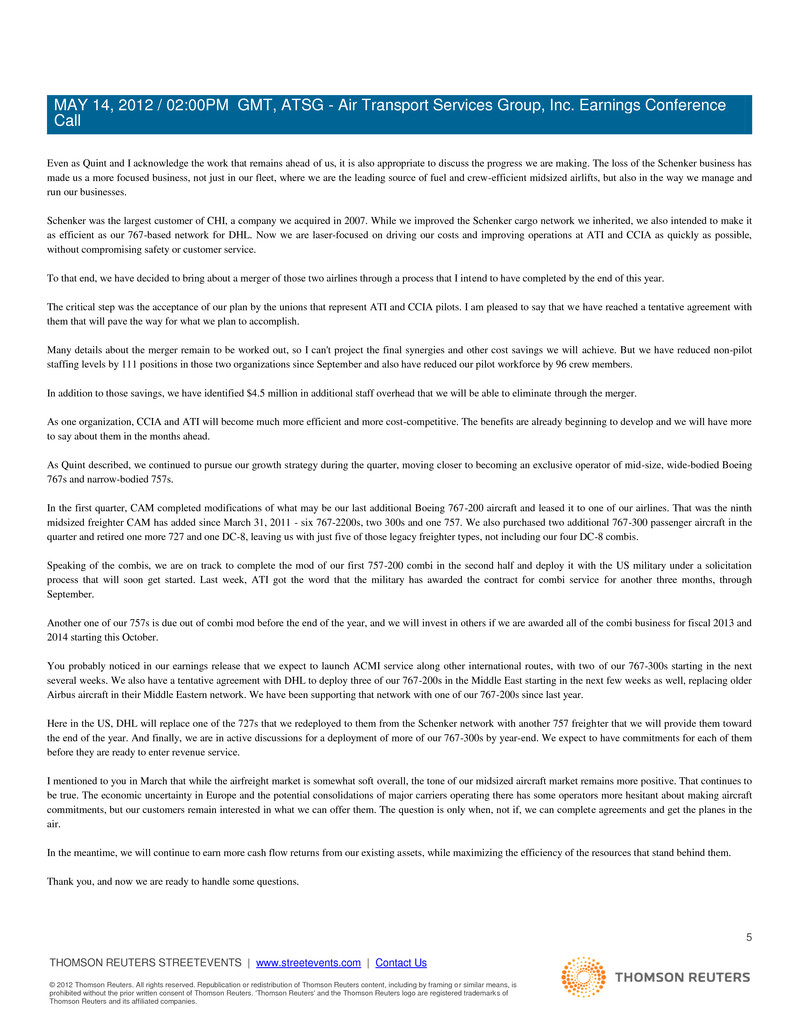
MAY 14, 2012 / 02:00PM GMT, ATSG - Air Transport Services Group, Inc. Earnings Conference Call 5 THOMSON REUTERS STREETEVENTS | www.streetevents.com | Contact Us © 2012 Thomson Reuters. All rights reserved. Republication or redistribution of Thomson Reuters content, including by framing or similar means, is prohibited without the prior written consent of Thomson Reuters. 'Thomson Reuters' and the Thomson Reuters logo are registered trademarks of Thomson Reuters and its affiliated companies. Even as Quint and I acknowledge the work that remains ahead of us, it is also appropriate to discuss the progress we are making. The loss of the Schenker business has made us a more focused business, not just in our fleet, where we are the leading source of fuel and crew-efficient midsized airlifts, but also in the way we manage and run our businesses. Schenker was the largest customer of CHI, a company we acquired in 2007. While we improved the Schenker cargo network we inherited, we also intended to make it as efficient as our 767-based network for DHL. Now we are laser-focused on driving our costs and improving operations at ATI and CCIA as quickly as possible, without compromising safety or customer service. To that end, we have decided to bring about a merger of those two airlines through a process that I intend to have completed by the end of this year. The critical step was the acceptance of our plan by the unions that represent ATI and CCIA pilots. I am pleased to say that we have reached a tentative agreement with them that will pave the way for what we plan to accomplish. Many details about the merger remain to be worked out, so I can't project the final synergies and other cost savings we will achieve. But we have reduced non-pilot staffing levels by 111 positions in those two organizations since September and also have reduced our pilot workforce by 96 crew members. In addition to those savings, we have identified $4.5 million in additional staff overhead that we will be able to eliminate through the merger. As one organization, CCIA and ATI will become much more efficient and more cost-competitive. The benefits are already beginning to develop and we will have more to say about them in the months ahead. As Quint described, we continued to pursue our growth strategy during the quarter, moving closer to becoming an exclusive operator of mid-size, wide-bodied Boeing 767s and narrow-bodied 757s. In the first quarter, CAM completed modifications of what may be our last additional Boeing 767-200 aircraft and leased it to one of our airlines. That was the ninth midsized freighter CAM has added since March 31, 2011 - six 767-2200s, two 300s and one 757. We also purchased two additional 767-300 passenger aircraft in the quarter and retired one more 727 and one DC-8, leaving us with just five of those legacy freighter types, not including our four DC-8 combis. Speaking of the combis, we are on track to complete the mod of our first 757-200 combi in the second half and deploy it with the US military under a solicitation process that will soon get started. Last week, ATI got the word that the military has awarded the contract for combi service for another three months, through September. Another one of our 757s is due out of combi mod before the end of the year, and we will invest in others if we are awarded all of the combi business for fiscal 2013 and 2014 starting this October. You probably noticed in our earnings release that we expect to launch ACMI service along other international routes, with two of our 767-300s starting in the next several weeks. We also have a tentative agreement with DHL to deploy three of our 767-200s in the Middle East starting in the next few weeks as well, replacing older Airbus aircraft in their Middle Eastern network. We have been supporting that network with one of our 767-200s since last year. Here in the US, DHL will replace one of the 727s that we redeployed to them from the Schenker network with another 757 freighter that we will provide them toward the end of the year. And finally, we are in active discussions for a deployment of more of our 767-300s by year-end. We expect to have commitments for each of them before they are ready to enter revenue service. I mentioned to you in March that while the airfreight market is somewhat soft overall, the tone of our midsized aircraft market remains more positive. That continues to be true. The economic uncertainty in Europe and the potential consolidations of major carriers operating there has some operators more hesitant about making aircraft commitments, but our customers remain interested in what we can offer them. The question is only when, not if, we can complete agreements and get the planes in the air. In the meantime, we will continue to earn more cash flow returns from our existing assets, while maximizing the efficiency of the resources that stand behind them. Thank you, and now we are ready to handle some questions.
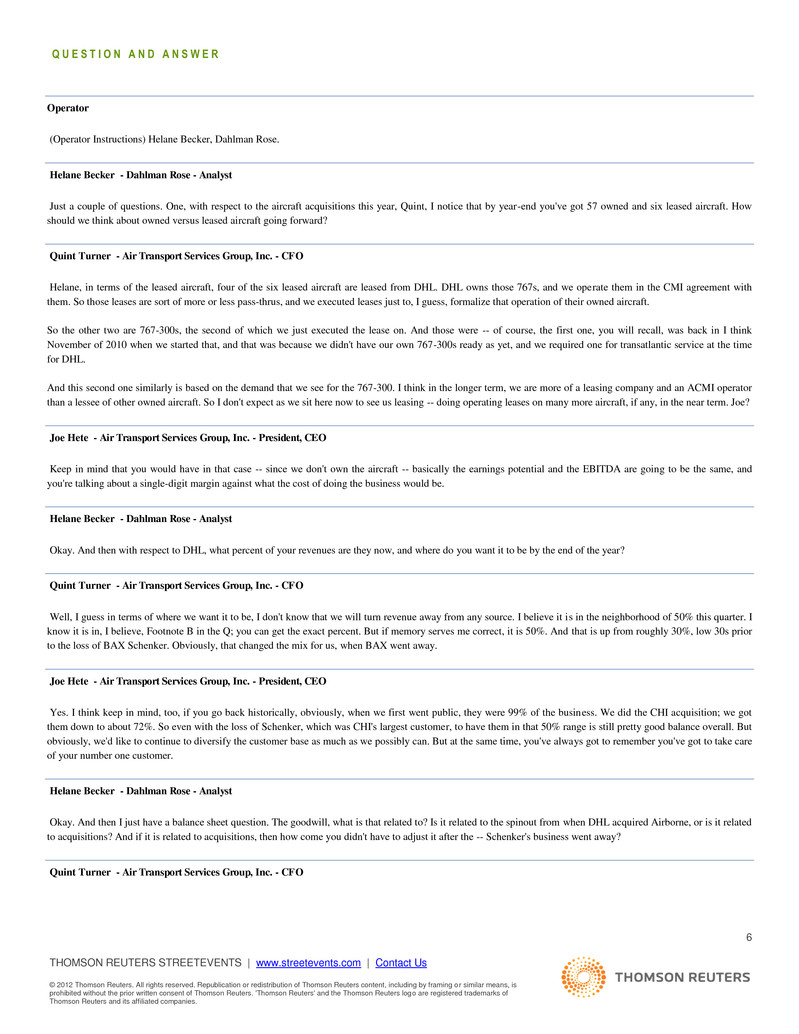
6 THOMSON REUTERS STREETEVENTS | www.streetevents.com | Contact Us © 2012 Thomson Reuters. All rights reserved. Republication or redistribution of Thomson Reuters content, including by framing or similar means, is prohibited without the prior written consent of Thomson Reuters. 'Thomson Reuters' and the Thomson Reuters logo are registered trademarks of Thomson Reuters and its affiliated companies. Q U E S T I O N A N D A N S W E R Operator (Operator Instructions) Helane Becker, Dahlman Rose. Helane Becker - Dahlman Rose - Analyst Just a couple of questions. One, with respect to the aircraft acquisitions this year, Quint, I notice that by year-end you've got 57 owned and six leased aircraft. How should we think about owned versus leased aircraft going forward? Quint Turner - Air Transport Services Group, Inc. - CFO Helane, in terms of the leased aircraft, four of the six leased aircraft are leased from DHL. DHL owns those 767s, and we operate them in the CMI agreement with them. So those leases are sort of more or less pass-thrus, and we executed leases just to, I guess, formalize that operation of their owned aircraft. So the other two are 767-300s, the second of which we just executed the lease on. And those were -- of course, the first one, you will recall, was back in I think November of 2010 when we started that, and that was because we didn't have our own 767-300s ready as yet, and we required one for transatlantic service at the time for DHL. And this second one similarly is based on the demand that we see for the 767-300. I think in the longer term, we are more of a leasing company and an ACMI operator than a lessee of other owned aircraft. So I don't expect as we sit here now to see us leasing -- doing operating leases on many more aircraft, if any, in the near term. Joe? Joe Hete - Air Transport Services Group, Inc. - President, CEO Keep in mind that you would have in that case -- since we don't own the aircraft -- basically the earnings potential and the EBITDA are going to be the same, and you're talking about a single-digit margin against what the cost of doing the business would be. Helane Becker - Dahlman Rose - Analyst Okay. And then with respect to DHL, what percent of your revenues are they now, and where do you want it to be by the end of the year? Quint Turner - Air Transport Services Group, Inc. - CFO Well, I guess in terms of where we want it to be, I don't know that we will turn revenue away from any source. I believe it is in the neighborhood of 50% this quarter. I know it is in, I believe, Footnote B in the Q; you can get the exact percent. But if memory serves me correct, it is 50%. And that is up from roughly 30%, low 30s prior to the loss of BAX Schenker. Obviously, that changed the mix for us, when BAX went away. Joe Hete - Air Transport Services Group, Inc. - President, CEO Yes. I think keep in mind, too, if you go back historically, obviously, when we first went public, they were 99% of the business. We did the CHI acquisition; we got them down to about 72%. So even with the loss of Schenker, which was CHI's largest customer, to have them in that 50% range is still pretty good balance overall. But obviously, we'd like to continue to diversify the customer base as much as we possibly can. But at the same time, you've always got to remember you've got to take care of your number one customer. Helane Becker - Dahlman Rose - Analyst Okay. And then I just have a balance sheet question. The goodwill, what is that related to? Is it related to the spinout from when DHL acquired Airborne, or is it related to acquisitions? And if it is related to acquisitions, then how come you didn't have to adjust it after the -- Schenker's business went away? Quint Turner - Air Transport Services Group, Inc. - CFO
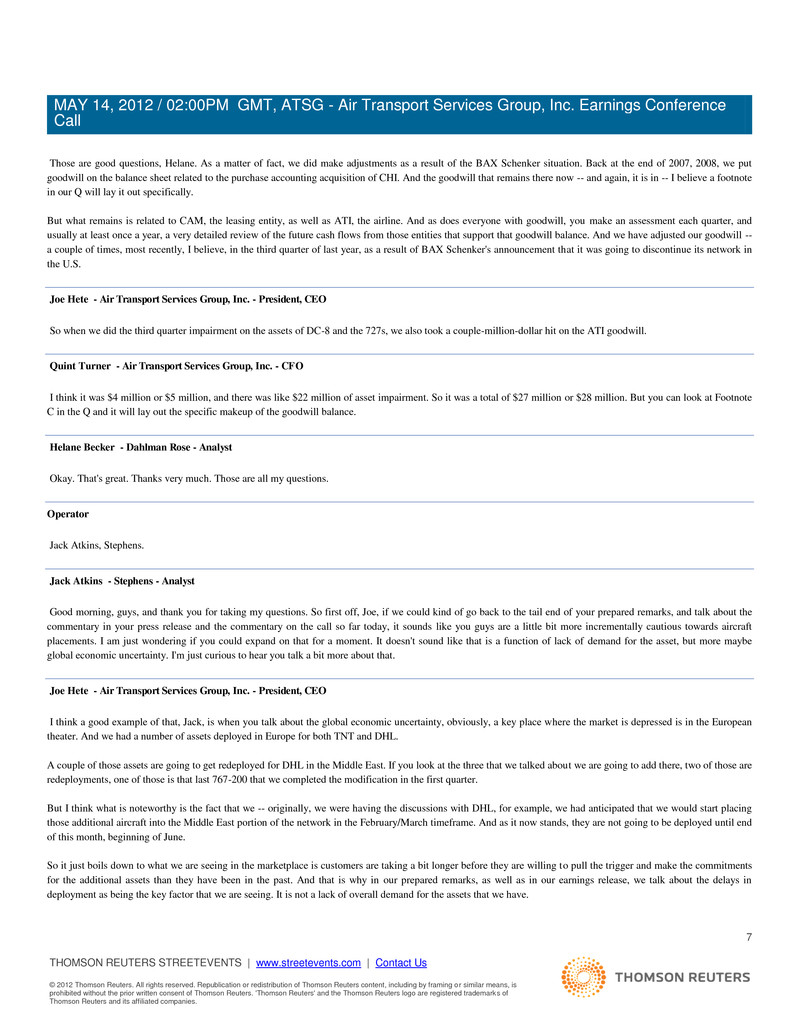
MAY 14, 2012 / 02:00PM GMT, ATSG - Air Transport Services Group, Inc. Earnings Conference Call 7 THOMSON REUTERS STREETEVENTS | www.streetevents.com | Contact Us © 2012 Thomson Reuters. All rights reserved. Republication or redistribution of Thomson Reuters content, including by framing or similar means, is prohibited without the prior written consent of Thomson Reuters. 'Thomson Reuters' and the Thomson Reuters logo are registered trademarks of Thomson Reuters and its affiliated companies. Those are good questions, Helane. As a matter of fact, we did make adjustments as a result of the BAX Schenker situation. Back at the end of 2007, 2008, we put goodwill on the balance sheet related to the purchase accounting acquisition of CHI. And the goodwill that remains there now -- and again, it is in -- I believe a footnote in our Q will lay it out specifically. But what remains is related to CAM, the leasing entity, as well as ATI, the airline. And as does everyone with goodwill, you make an assessment each quarter, and usually at least once a year, a very detailed review of the future cash flows from those entities that support that goodwill balance. And we have adjusted our goodwill -- a couple of times, most recently, I believe, in the third quarter of last year, as a result of BAX Schenker's announcement that it was going to discontinue its network in the U.S. Joe Hete - Air Transport Services Group, Inc. - President, CEO So when we did the third quarter impairment on the assets of DC-8 and the 727s, we also took a couple-million-dollar hit on the ATI goodwill. Quint Turner - Air Transport Services Group, Inc. - CFO I think it was $4 million or $5 million, and there was like $22 million of asset impairment. So it was a total of $27 million or $28 million. But you can look at Footnote C in the Q and it will lay out the specific makeup of the goodwill balance. Helane Becker - Dahlman Rose - Analyst Okay. That's great. Thanks very much. Those are all my questions. Operator Jack Atkins, Stephens. Jack Atkins - Stephens - Analyst Good morning, guys, and thank you for taking my questions. So first off, Joe, if we could kind of go back to the tail end of your prepared remarks, and talk about the commentary in your press release and the commentary on the call so far today, it sounds like you guys are a little bit more incrementally cautious towards aircraft placements. I am just wondering if you could expand on that for a moment. It doesn't sound like that is a function of lack of demand for the asset, but more maybe global economic uncertainty. I'm just curious to hear you talk a bit more about that. Joe Hete - Air Transport Services Group, Inc. - President, CEO I think a good example of that, Jack, is when you talk about the global economic uncertainty, obviously, a key place where the market is depressed is in the European theater. And we had a number of assets deployed in Europe for both TNT and DHL. A couple of those assets are going to get redeployed for DHL in the Middle East. If you look at the three that we talked about we are going to add there, two of those are redeployments, one of those is that last 767-200 that we completed the modification in the first quarter. But I think what is noteworthy is the fact that we -- originally, we were having the discussions with DHL, for example, we had anticipated that we would start placing those additional aircraft into the Middle East portion of the network in the February/March timeframe. And as it now stands, they are not going to be deployed until end of this month, beginning of June. So it just boils down to what we are seeing in the marketplace is customers are taking a bit longer before they are willing to pull the trigger and make the commitments for the additional assets than they have been in the past. And that is why in our prepared remarks, as well as in our earnings release, we talk about the delays in deployment as being the key factor that we are seeing. It is not a lack of overall demand for the assets that we have.
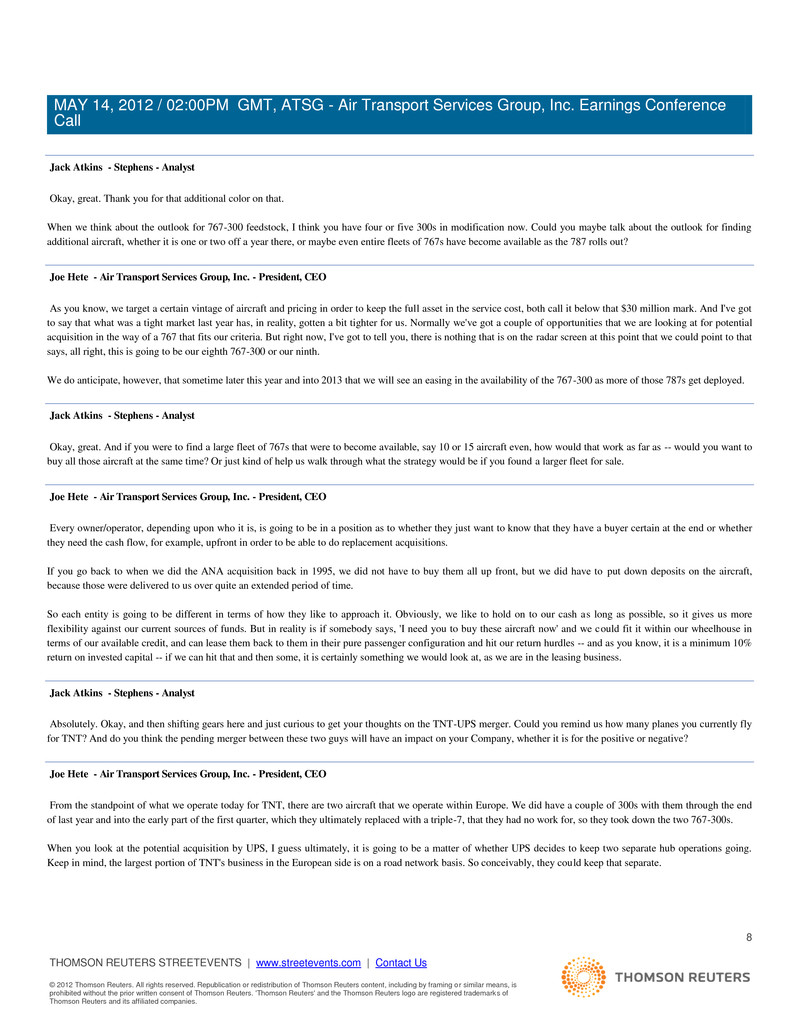
MAY 14, 2012 / 02:00PM GMT, ATSG - Air Transport Services Group, Inc. Earnings Conference Call 8 THOMSON REUTERS STREETEVENTS | www.streetevents.com | Contact Us © 2012 Thomson Reuters. All rights reserved. Republication or redistribution of Thomson Reuters content, including by framing or similar means, is prohibited without the prior written consent of Thomson Reuters. 'Thomson Reuters' and the Thomson Reuters logo are registered trademarks of Thomson Reuters and its affiliated companies. Jack Atkins - Stephens - Analyst Okay, great. Thank you for that additional color on that. When we think about the outlook for 767-300 feedstock, I think you have four or five 300s in modification now. Could you maybe talk about the outlook for finding additional aircraft, whether it is one or two off a year there, or maybe even entire fleets of 767s have become available as the 787 rolls out? Joe Hete - Air Transport Services Group, Inc. - President, CEO As you know, we target a certain vintage of aircraft and pricing in order to keep the full asset in the service cost, both call it below that $30 million mark. And I've got to say that what was a tight market last year has, in reality, gotten a bit tighter for us. Normally we've got a couple of opportunities that we are looking at for potential acquisition in the way of a 767 that fits our criteria. But right now, I've got to tell you, there is nothing that is on the radar screen at this point that we could point to that says, all right, this is going to be our eighth 767-300 or our ninth. We do anticipate, however, that sometime later this year and into 2013 that we will see an easing in the availability of the 767-300 as more of those 787s get deployed. Jack Atkins - Stephens - Analyst Okay, great. And if you were to find a large fleet of 767s that were to become available, say 10 or 15 aircraft even, how would that work as far as -- would you want to buy all those aircraft at the same time? Or just kind of help us walk through what the strategy would be if you found a larger fleet for sale. Joe Hete - Air Transport Services Group, Inc. - President, CEO Every owner/operator, depending upon who it is, is going to be in a position as to whether they just want to know that they have a buyer certain at the end or whether they need the cash flow, for example, upfront in order to be able to do replacement acquisitions. If you go back to when we did the ANA acquisition back in 1995, we did not have to buy them all up front, but we did have to put down deposits on the aircraft, because those were delivered to us over quite an extended period of time. So each entity is going to be different in terms of how they like to approach it. Obviously, we like to hold on to our cash as long as possible, so it gives us more flexibility against our current sources of funds. But in reality is if somebody says, 'I need you to buy these aircraft now' and we could fit it within our wheelhouse in terms of our available credit, and can lease them back to them in their pure passenger configuration and hit our return hurdles -- and as you know, it is a minimum 10% return on invested capital -- if we can hit that and then some, it is certainly something we would look at, as we are in the leasing business. Jack Atkins - Stephens - Analyst Absolutely. Okay, and then shifting gears here and just curious to get your thoughts on the TNT-UPS merger. Could you remind us how many planes you currently fly for TNT? And do you think the pending merger between these two guys will have an impact on your Company, whether it is for the positive or negative? Joe Hete - Air Transport Services Group, Inc. - President, CEO From the standpoint of what we operate today for TNT, there are two aircraft that we operate within Europe. We did have a couple of 300s with them through the end of last year and into the early part of the first quarter, which they ultimately replaced with a triple-7, that they had no work for, so they took down the two 767-300s. When you look at the potential acquisition by UPS, I guess ultimately, it is going to be a matter of whether UPS decides to keep two separate hub operations going. Keep in mind, the largest portion of TNT's business in the European side is on a road network basis. So conceivably, they could keep that separate.
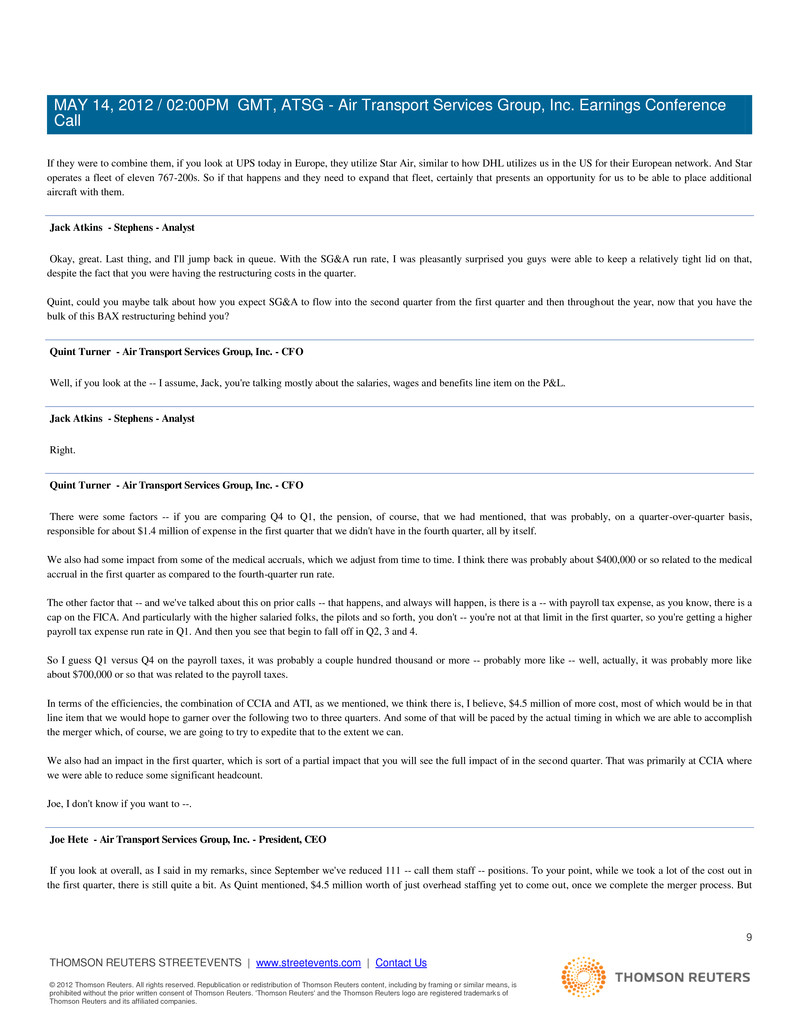
MAY 14, 2012 / 02:00PM GMT, ATSG - Air Transport Services Group, Inc. Earnings Conference Call 9 THOMSON REUTERS STREETEVENTS | www.streetevents.com | Contact Us © 2012 Thomson Reuters. All rights reserved. Republication or redistribution of Thomson Reuters content, including by framing or similar means, is prohibited without the prior written consent of Thomson Reuters. 'Thomson Reuters' and the Thomson Reuters logo are registered trademarks of Thomson Reuters and its affiliated companies. If they were to combine them, if you look at UPS today in Europe, they utilize Star Air, similar to how DHL utilizes us in the US for their European network. And Star operates a fleet of eleven 767-200s. So if that happens and they need to expand that fleet, certainly that presents an opportunity for us to be able to place additional aircraft with them. Jack Atkins - Stephens - Analyst Okay, great. Last thing, and I'll jump back in queue. With the SG&A run rate, I was pleasantly surprised you guys were able to keep a relatively tight lid on that, despite the fact that you were having the restructuring costs in the quarter. Quint, could you maybe talk about how you expect SG&A to flow into the second quarter from the first quarter and then throughout the year, now that you have the bulk of this BAX restructuring behind you? Quint Turner - Air Transport Services Group, Inc. - CFO Well, if you look at the -- I assume, Jack, you're talking mostly about the salaries, wages and benefits line item on the P&L. Jack Atkins - Stephens - Analyst Right. Quint Turner - Air Transport Services Group, Inc. - CFO There were some factors -- if you are comparing Q4 to Q1, the pension, of course, that we had mentioned, that was probably, on a quarter-over-quarter basis, responsible for about $1.4 million of expense in the first quarter that we didn't have in the fourth quarter, all by itself. We also had some impact from some of the medical accruals, which we adjust from time to time. I think there was probably about $400,000 or so related to the medical accrual in the first quarter as compared to the fourth-quarter run rate. The other factor that -- and we've talked about this on prior calls -- that happens, and always will happen, is there is a -- with payroll tax expense, as you know, there is a cap on the FICA. And particularly with the higher salaried folks, the pilots and so forth, you don't -- you're not at that limit in the first quarter, so you're getting a higher payroll tax expense run rate in Q1. And then you see that begin to fall off in Q2, 3 and 4. So I guess Q1 versus Q4 on the payroll taxes, it was probably a couple hundred thousand or more -- probably more like -- well, actually, it was probably more like about $700,000 or so that was related to the payroll taxes. In terms of the efficiencies, the combination of CCIA and ATI, as we mentioned, we think there is, I believe, $4.5 million of more cost, most of which would be in that line item that we would hope to garner over the following two to three quarters. And some of that will be paced by the actual timing in which we are able to accomplish the merger which, of course, we are going to try to expedite that to the extent we can. We also had an impact in the first quarter, which is sort of a partial impact that you will see the full impact of in the second quarter. That was primarily at CCIA where we were able to reduce some significant headcount. Joe, I don't know if you want to --. Joe Hete - Air Transport Services Group, Inc. - President, CEO If you look at overall, as I said in my remarks, since September we've reduced 111 -- call them staff -- positions. To your point, while we took a lot of the cost out in the first quarter, there is still quite a bit. As Quint mentioned, $4.5 million worth of just overhead staffing yet to come out, once we complete the merger process. But
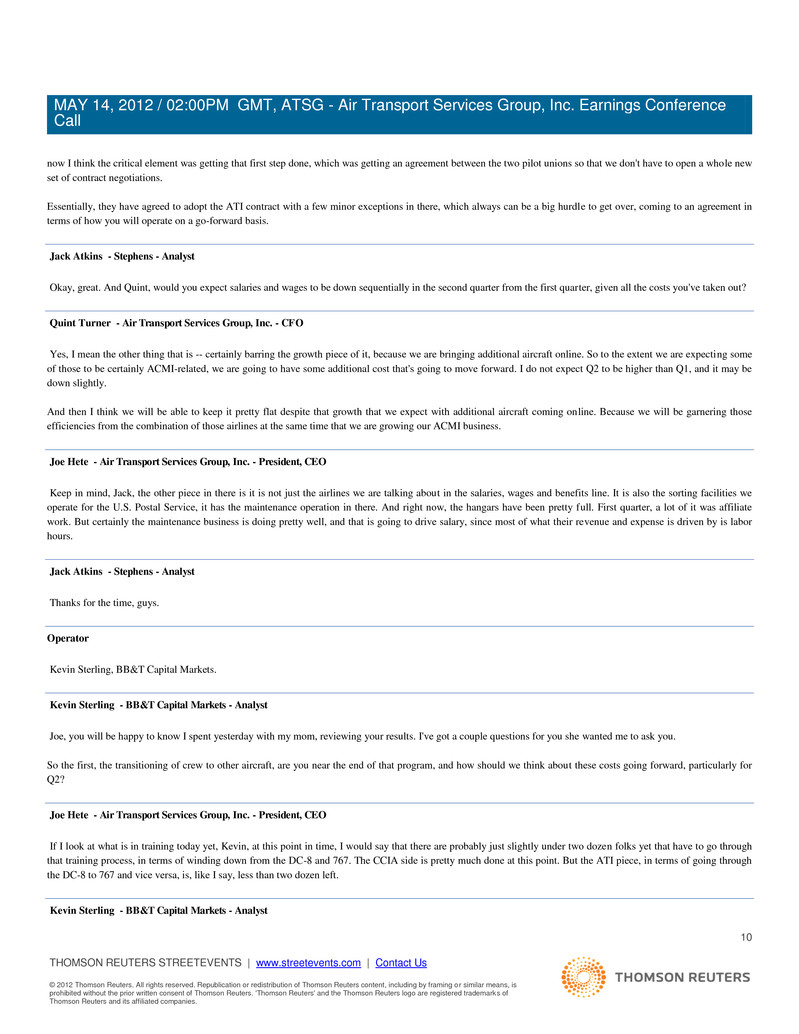
MAY 14, 2012 / 02:00PM GMT, ATSG - Air Transport Services Group, Inc. Earnings Conference Call 10 THOMSON REUTERS STREETEVENTS | www.streetevents.com | Contact Us © 2012 Thomson Reuters. All rights reserved. Republication or redistribution of Thomson Reuters content, including by framing or similar means, is prohibited without the prior written consent of Thomson Reuters. 'Thomson Reuters' and the Thomson Reuters logo are registered trademarks of Thomson Reuters and its affiliated companies. now I think the critical element was getting that first step done, which was getting an agreement between the two pilot unions so that we don't have to open a whole new set of contract negotiations. Essentially, they have agreed to adopt the ATI contract with a few minor exceptions in there, which always can be a big hurdle to get over, coming to an agreement in terms of how you will operate on a go-forward basis. Jack Atkins - Stephens - Analyst Okay, great. And Quint, would you expect salaries and wages to be down sequentially in the second quarter from the first quarter, given all the costs you've taken out? Quint Turner - Air Transport Services Group, Inc. - CFO Yes, I mean the other thing that is -- certainly barring the growth piece of it, because we are bringing additional aircraft online. So to the extent we are expecting some of those to be certainly ACMI-related, we are going to have some additional cost that's going to move forward. I do not expect Q2 to be higher than Q1, and it may be down slightly. And then I think we will be able to keep it pretty flat despite that growth that we expect with additional aircraft coming online. Because we will be garnering those efficiencies from the combination of those airlines at the same time that we are growing our ACMI business. Joe Hete - Air Transport Services Group, Inc. - President, CEO Keep in mind, Jack, the other piece in there is it is not just the airlines we are talking about in the salaries, wages and benefits line. It is also the sorting facilities we operate for the U.S. Postal Service, it has the maintenance operation in there. And right now, the hangars have been pretty full. First quarter, a lot of it was affiliate work. But certainly the maintenance business is doing pretty well, and that is going to drive salary, since most of what their revenue and expense is driven by is labor hours. Jack Atkins - Stephens - Analyst Thanks for the time, guys. Operator Kevin Sterling, BB&T Capital Markets. Kevin Sterling - BB&T Capital Markets - Analyst Joe, you will be happy to know I spent yesterday with my mom, reviewing your results. I've got a couple questions for you she wanted me to ask you. So the first, the transitioning of crew to other aircraft, are you near the end of that program, and how should we think about these costs going forward, particularly for Q2? Joe Hete - Air Transport Services Group, Inc. - President, CEO If I look at what is in training today yet, Kevin, at this point in time, I would say that there are probably just slightly under two dozen folks yet that have to go through that training process, in terms of winding down from the DC-8 and 767. The CCIA side is pretty much done at this point. But the ATI piece, in terms of going through the DC-8 to 767 and vice versa, is, like I say, less than two dozen left. Kevin Sterling - BB&T Capital Markets - Analyst
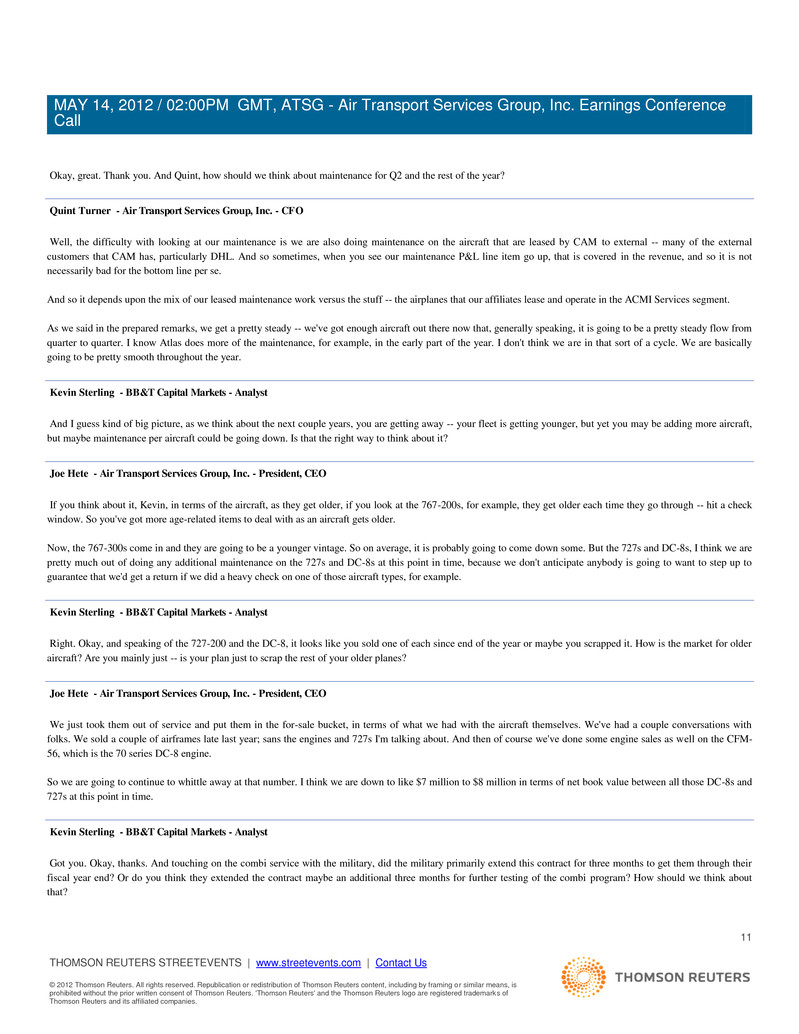
MAY 14, 2012 / 02:00PM GMT, ATSG - Air Transport Services Group, Inc. Earnings Conference Call 11 THOMSON REUTERS STREETEVENTS | www.streetevents.com | Contact Us © 2012 Thomson Reuters. All rights reserved. Republication or redistribution of Thomson Reuters content, including by framing or similar means, is prohibited without the prior written consent of Thomson Reuters. 'Thomson Reuters' and the Thomson Reuters logo are registered trademarks of Thomson Reuters and its affiliated companies. Okay, great. Thank you. And Quint, how should we think about maintenance for Q2 and the rest of the year? Quint Turner - Air Transport Services Group, Inc. - CFO Well, the difficulty with looking at our maintenance is we are also doing maintenance on the aircraft that are leased by CAM to external -- many of the external customers that CAM has, particularly DHL. And so sometimes, when you see our maintenance P&L line item go up, that is covered in the revenue, and so it is not necessarily bad for the bottom line per se. And so it depends upon the mix of our leased maintenance work versus the stuff -- the airplanes that our affiliates lease and operate in the ACMI Services segment. As we said in the prepared remarks, we get a pretty steady -- we've got enough aircraft out there now that, generally speaking, it is going to be a pretty steady flow from quarter to quarter. I know Atlas does more of the maintenance, for example, in the early part of the year. I don't think we are in that sort of a cycle. We are basically going to be pretty smooth throughout the year. Kevin Sterling - BB&T Capital Markets - Analyst And I guess kind of big picture, as we think about the next couple years, you are getting away -- your fleet is getting younger, but yet you may be adding more aircraft, but maybe maintenance per aircraft could be going down. Is that the right way to think about it? Joe Hete - Air Transport Services Group, Inc. - President, CEO If you think about it, Kevin, in terms of the aircraft, as they get older, if you look at the 767-200s, for example, they get older each time they go through -- hit a check window. So you've got more age-related items to deal with as an aircraft gets older. Now, the 767-300s come in and they are going to be a younger vintage. So on average, it is probably going to come down some. But the 727s and DC-8s, I think we are pretty much out of doing any additional maintenance on the 727s and DC-8s at this point in time, because we don't anticipate anybody is going to want to step up to guarantee that we'd get a return if we did a heavy check on one of those aircraft types, for example. Kevin Sterling - BB&T Capital Markets - Analyst Right. Okay, and speaking of the 727-200 and the DC-8, it looks like you sold one of each since end of the year or maybe you scrapped it. How is the market for older aircraft? Are you mainly just -- is your plan just to scrap the rest of your older planes? Joe Hete - Air Transport Services Group, Inc. - President, CEO We just took them out of service and put them in the for-sale bucket, in terms of what we had with the aircraft themselves. We've had a couple conversations with folks. We sold a couple of airframes late last year; sans the engines and 727s I'm talking about. And then of course we've done some engine sales as well on the CFM- 56, which is the 70 series DC-8 engine. So we are going to continue to whittle away at that number. I think we are down to like $7 million to $8 million in terms of net book value between all those DC-8s and 727s at this point in time. Kevin Sterling - BB&T Capital Markets - Analyst Got you. Okay, thanks. And touching on the combi service with the military, did the military primarily extend this contract for three months to get them through their fiscal year end? Or do you think they extended the contract maybe an additional three months for further testing of the combi program? How should we think about that?
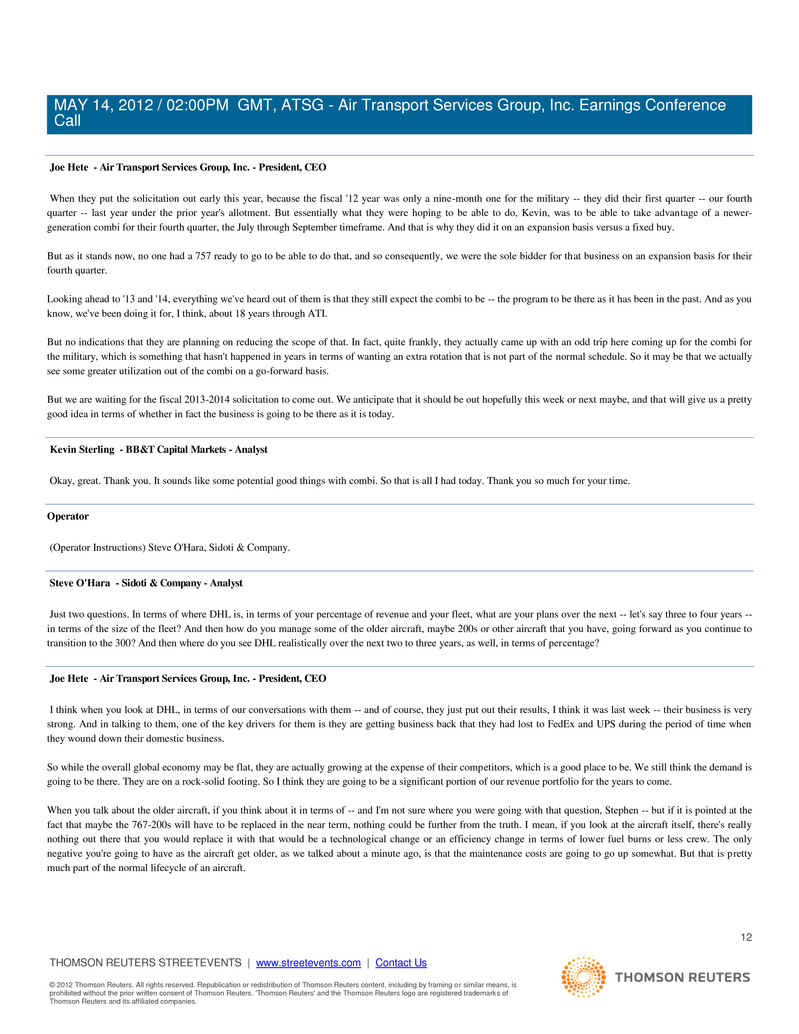
MAY 14, 2012 / 02:00PM GMT, ATSG - Air Transport Services Group, Inc. Earnings Conference Call 12 THOMSON REUTERS STREETEVENTS | www.streetevents.com | Contact Us © 2012 Thomson Reuters. All rights reserved. Republication or redistribution of Thomson Reuters content, including by framing or similar means, is prohibited without the prior written consent of Thomson Reuters. 'Thomson Reuters' and the Thomson Reuters logo are registered trademarks of Thomson Reuters and its affiliated companies. Joe Hete - Air Transport Services Group, Inc. - President, CEO When they put the solicitation out early this year, because the fiscal '12 year was only a nine-month one for the military -- they did their first quarter -- our fourth quarter -- last year under the prior year's allotment. But essentially what they were hoping to be able to do, Kevin, was to be able to take advantage of a newer- generation combi for their fourth quarter, the July through September timeframe. And that is why they did it on an expansion basis versus a fixed buy. But as it stands now, no one had a 757 ready to go to be able to do that, and so consequently, we were the sole bidder for that business on an expansion basis for their fourth quarter. Looking ahead to '13 and '14, everything we've heard out of them is that they still expect the combi to be -- the program to be there as it has been in the past. And as you know, we've been doing it for, I think, about 18 years through ATI. But no indications that they are planning on reducing the scope of that. In fact, quite frankly, they actually came up with an odd trip here coming up for the combi for the military, which is something that hasn't happened in years in terms of wanting an extra rotation that is not part of the normal schedule. So it may be that we actually see some greater utilization out of the combi on a go-forward basis. But we are waiting for the fiscal 2013-2014 solicitation to come out. We anticipate that it should be out hopefully this week or next maybe, and that will give us a pretty good idea in terms of whether in fact the business is going to be there as it is today. Kevin Sterling - BB&T Capital Markets - Analyst Okay, great. Thank you. It sounds like some potential good things with combi. So that is all I had today. Thank you so much for your time. Operator (Operator Instructions) Steve O'Hara, Sidoti & Company. Steve O'Hara - Sidoti & Company - Analyst Just two questions. In terms of where DHL is, in terms of your percentage of revenue and your fleet, what are your plans over the next -- let's say three to four years -- in terms of the size of the fleet? And then how do you manage some of the older aircraft, maybe 200s or other aircraft that you have, going forward as you continue to transition to the 300? And then where do you see DHL realistically over the next two to three years, as well, in terms of percentage? Joe Hete - Air Transport Services Group, Inc. - President, CEO I think when you look at DHL, in terms of our conversations with them -- and of course, they just put out their results, I think it was last week -- their business is very strong. And in talking to them, one of the key drivers for them is they are getting business back that they had lost to FedEx and UPS during the period of time when they wound down their domestic business. So while the overall global economy may be flat, they are actually growing at the expense of their competitors, which is a good place to be. We still think the demand is going to be there. They are on a rock-solid footing. So I think they are going to be a significant portion of our revenue portfolio for the years to come. When you talk about the older aircraft, if you think about it in terms of -- and I'm not sure where you were going with that question, Stephen -- but if it is pointed at the fact that maybe the 767-200s will have to be replaced in the near term, nothing could be further from the truth. I mean, if you look at the aircraft itself, there's really nothing out there that you would replace it with that would be a technological change or an efficiency change in terms of lower fuel burns or less crew. The only negative you're going to have as the aircraft get older, as we talked about a minute ago, is that the maintenance costs are going to go up somewhat. But that is pretty much part of the normal lifecycle of an aircraft.

MAY 14, 2012 / 02:00PM GMT, ATSG - Air Transport Services Group, Inc. Earnings Conference Call 13 THOMSON REUTERS STREETEVENTS | www.streetevents.com | Contact Us © 2012 Thomson Reuters. All rights reserved. Republication or redistribution of Thomson Reuters content, including by framing or similar means, is prohibited without the prior written consent of Thomson Reuters. 'Thomson Reuters' and the Thomson Reuters logo are registered trademarks of Thomson Reuters and its affiliated companies. But where we see the opportunity for the 300s is not to replace the 200s in terms of them being obsolete or too expensive to operate. It is more about growth opportunities. And that is one of the key things that we have to balance today, is a lot of our customers that have the 767-200 would like to upgrade to the 300s in many cases because of the greater range and capacity that the 300 brings to the table. But obviously, we are willing to entertain those, but first we've got to find a home for the 767-200 they'd like to swap it out for. Steve O'Hara - Sidoti & Company - Analyst Okay. I mean, I guess that is kind of my question. So in terms of customer preference, obviously -- do you see a strong preference in customers between the 200 and 300, and might that lead some of the older 200s to be replaced by 300s? Joe Hete - Air Transport Services Group, Inc. - President, CEO I don't think that's going to be a problem for us, Steve. Quint Turner - Air Transport Services Group, Inc. - CFO It really depends upon the mission of the airplane. Joe always says, the 300 is a great airplane, but you got to fill it up and your load has to match what the capacity is. And the 200 is a great airplane for networks in particular, and I think it will have a long life-cycle in those type missions. Steve O'Hara - Sidoti & Company - Analyst Okay. And then could you just in terms of the -- maybe the fleet growth over the next couple of years, I'm sure you don't want to put a hard number out there. But how should we think about it over the next two to three years? Joe Hete - Air Transport Services Group, Inc. - President, CEO I think as we've met with you, Stephen, and of course, you've been on some investor visits with us. And what we've always talked about is that you can anticipate somewhere in the range of four to six 767-300s being added to the fleet on an annual basis, without us having to dip into the credit markets in a big way. Equally so, we are seeing some demand, as we noted in our earnings release as well as in the call today, that DHL is looking to replace some of the 727s that we have still operating for them with the 757. They've come to an agreement basically on the terms for adding a fourth one into the equation. So we may see a little bit of growth in the 757 side of the marketplace as well. Steve O'Hara - Sidoti & Company - Analyst Okay, thank you very much. Operator Adam Ritzer of R. W. Pressprich & Co Adam Ritzer - R. W. Pressprich & Co - Analyst Just real quick, can you give me more of an update on how many modifications we have coming in for the rest of this year and how many are not contracted for yet, if any? Joe Hete - Air Transport Services Group, Inc. - President, CEO
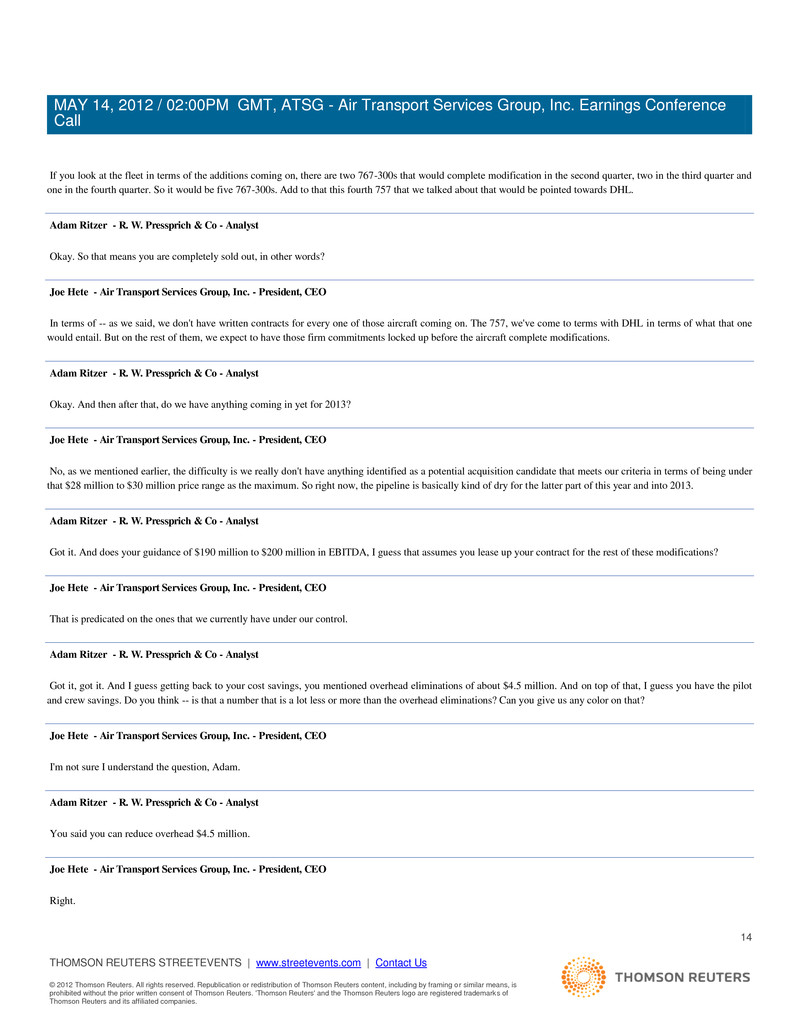
MAY 14, 2012 / 02:00PM GMT, ATSG - Air Transport Services Group, Inc. Earnings Conference Call 14 THOMSON REUTERS STREETEVENTS | www.streetevents.com | Contact Us © 2012 Thomson Reuters. All rights reserved. Republication or redistribution of Thomson Reuters content, including by framing or similar means, is prohibited without the prior written consent of Thomson Reuters. 'Thomson Reuters' and the Thomson Reuters logo are registered trademarks of Thomson Reuters and its affiliated companies. If you look at the fleet in terms of the additions coming on, there are two 767-300s that would complete modification in the second quarter, two in the third quarter and one in the fourth quarter. So it would be five 767-300s. Add to that this fourth 757 that we talked about that would be pointed towards DHL. Adam Ritzer - R. W. Pressprich & Co - Analyst Okay. So that means you are completely sold out, in other words? Joe Hete - Air Transport Services Group, Inc. - President, CEO In terms of -- as we said, we don't have written contracts for every one of those aircraft coming on. The 757, we've come to terms with DHL in terms of what that one would entail. But on the rest of them, we expect to have those firm commitments locked up before the aircraft complete modifications. Adam Ritzer - R. W. Pressprich & Co - Analyst Okay. And then after that, do we have anything coming in yet for 2013? Joe Hete - Air Transport Services Group, Inc. - President, CEO No, as we mentioned earlier, the difficulty is we really don't have anything identified as a potential acquisition candidate that meets our criteria in terms of being under that $28 million to $30 million price range as the maximum. So right now, the pipeline is basically kind of dry for the latter part of this year and into 2013. Adam Ritzer - R. W. Pressprich & Co - Analyst Got it. And does your guidance of $190 million to $200 million in EBITDA, I guess that assumes you lease up your contract for the rest of these modifications? Joe Hete - Air Transport Services Group, Inc. - President, CEO That is predicated on the ones that we currently have under our control. Adam Ritzer - R. W. Pressprich & Co - Analyst Got it, got it. And I guess getting back to your cost savings, you mentioned overhead eliminations of about $4.5 million. And on top of that, I guess you have the pilot and crew savings. Do you think -- is that a number that is a lot less or more than the overhead eliminations? Can you give us any color on that? Joe Hete - Air Transport Services Group, Inc. - President, CEO I'm not sure I understand the question, Adam. Adam Ritzer - R. W. Pressprich & Co - Analyst You said you can reduce overhead $4.5 million. Joe Hete - Air Transport Services Group, Inc. - President, CEO Right.
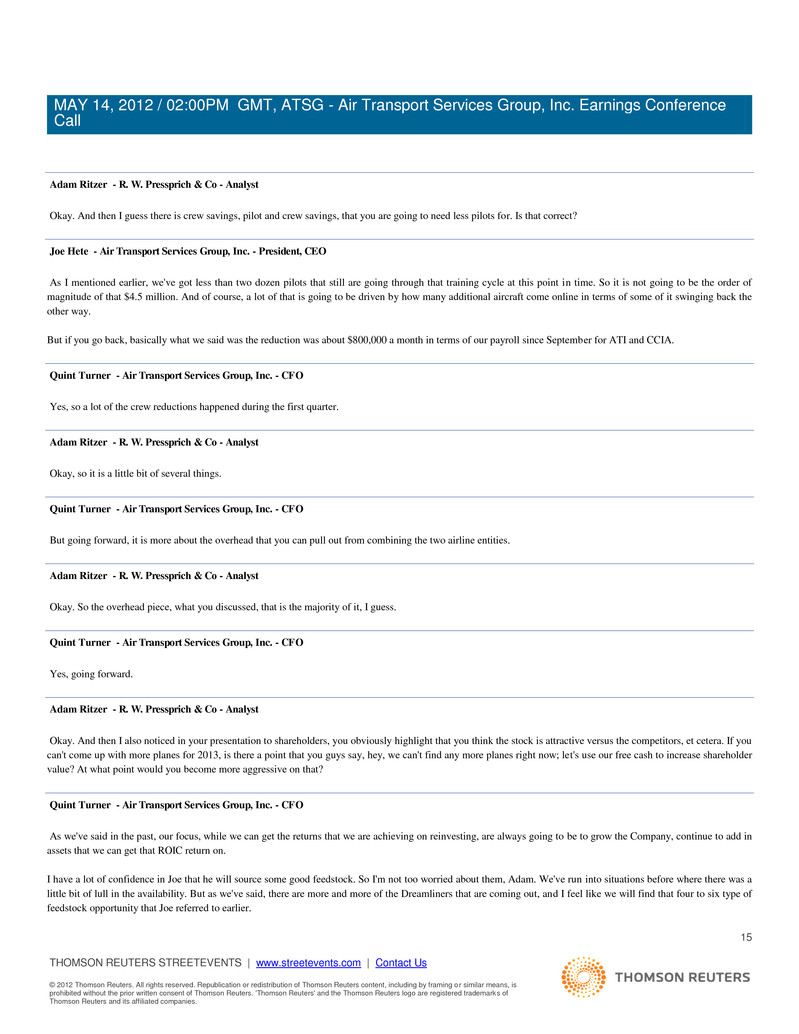
MAY 14, 2012 / 02:00PM GMT, ATSG - Air Transport Services Group, Inc. Earnings Conference Call 15 THOMSON REUTERS STREETEVENTS | www.streetevents.com | Contact Us © 2012 Thomson Reuters. All rights reserved. Republication or redistribution of Thomson Reuters content, including by framing or similar means, is prohibited without the prior written consent of Thomson Reuters. 'Thomson Reuters' and the Thomson Reuters logo are registered trademarks of Thomson Reuters and its affiliated companies. Adam Ritzer - R. W. Pressprich & Co - Analyst Okay. And then I guess there is crew savings, pilot and crew savings, that you are going to need less pilots for. Is that correct? Joe Hete - Air Transport Services Group, Inc. - President, CEO As I mentioned earlier, we've got less than two dozen pilots that still are going through that training cycle at this point in time. So it is not going to be the order of magnitude of that $4.5 million. And of course, a lot of that is going to be driven by how many additional aircraft come online in terms of some of it swinging back the other way. But if you go back, basically what we said was the reduction was about $800,000 a month in terms of our payroll since September for ATI and CCIA. Quint Turner - Air Transport Services Group, Inc. - CFO Yes, so a lot of the crew reductions happened during the first quarter. Adam Ritzer - R. W. Pressprich & Co - Analyst Okay, so it is a little bit of several things. Quint Turner - Air Transport Services Group, Inc. - CFO But going forward, it is more about the overhead that you can pull out from combining the two airline entities. Adam Ritzer - R. W. Pressprich & Co - Analyst Okay. So the overhead piece, what you discussed, that is the majority of it, I guess. Quint Turner - Air Transport Services Group, Inc. - CFO Yes, going forward. Adam Ritzer - R. W. Pressprich & Co - Analyst Okay. And then I also noticed in your presentation to shareholders, you obviously highlight that you think the stock is attractive versus the competitors, et cetera. If you can't come up with more planes for 2013, is there a point that you guys say, hey, we can't find any more planes right now; let's use our free cash to increase shareholder value? At what point would you become more aggressive on that? Quint Turner - Air Transport Services Group, Inc. - CFO As we've said in the past, our focus, while we can get the returns that we are achieving on reinvesting, are always going to be to grow the Company, continue to add in assets that we can get that ROIC return on. I have a lot of confidence in Joe that he will source some good feedstock. So I'm not too worried about them, Adam. We've run into situations before where there was a little bit of lull in the availability. But as we've said, there are more and more of the Dreamliners that are coming out, and I feel like we will find that four to six type of feedstock opportunity that Joe referred to earlier.

MAY 14, 2012 / 02:00PM GMT, ATSG - Air Transport Services Group, Inc. Earnings Conference Call 16 THOMSON REUTERS STREETEVENTS | www.streetevents.com | Contact Us © 2012 Thomson Reuters. All rights reserved. Republication or redistribution of Thomson Reuters content, including by framing or similar means, is prohibited without the prior written consent of Thomson Reuters. 'Thomson Reuters' and the Thomson Reuters logo are registered trademarks of Thomson Reuters and its affiliated companies. Adam Ritzer - R. W. Pressprich & Co - Analyst Okay, so basically, you think you are going to find them and that is where the cash is going to go? Okay, fair enough. Thanks for your time, guys. Operator Michael Chapman, Private Capital Management. Michael Chapman - Private Capital Management - Analyst Quick question. On the cash, when you guys generate it -- so the new planes you are getting put in the Middle East -- is the cash then resident in the Middle East? Or the work that you do in the Far East, does the cash stay there or does it all get repatriated back? Joe Hete - Air Transport Services Group, Inc. - President, CEO It all comes back. Quint Turner - Air Transport Services Group, Inc. - CFO Right, it comes back. Michael Chapman - Private Capital Management - Analyst Okay. And then I'm just trying to kind of walk through from here -- from first quarter to kind of fourth quarter, given the ramp in aircraft that you guys are having, the 75s coming on, the 76s coming on, you guys said the crew cost is relatively flat, you're going to have overhead come out. So if EBITDA this quarter was $33 million, did it go up by $4.5 million, $5 million from the overhead savings? Probably about $5 million or $6 million just from the new aircraft coming on, maybe a little bit more than that, because you have ACMI that you put those aircraft on. So that gives me about $10 million or $12 million in additional EBITDA. Is there additional that you expect to come from the military, from additional 7-5s to kind of get from $33 million to kind of like the $55 million run rate you would exit the year? How do I bridge that $33 million to $55 million? Quint Turner - Air Transport Services Group, Inc. - CFO Again, without kind of getting into a real fulsome discussion of what the quarter-by-quarter progression would be on EBITDA, I can tell you that the big items that will help us elevate that EBITDA to what we think is a run rate by fourth quarter of sort of -- on a quarterly run rate of $220 to $230 million type of run rate on an annualized basis -- what kind of gets you to that level is more about the placement of the aircraft that we've got coming out. As we mentioned, we've got five 767-300s that we own, as well as the 7-5, which DHL has spoken for. And we also had, as we say, a little bit of a delay in the first quarter in some of the placements. So we think that when you get the full impact, quarterly impact, of those additional aircraft, that is what is going to drive the EBITDA quarterly forward. I mean, certainly the cost reductions are a very important part of that, because they tend to go right to the -- as you know, direct to the bottom line, to some extent; the elimination of overhead, et cetera. So we will be focused on that. But it is a revenue issue that will elevate the EBITDA going forward for the most part. Michael Chapman - Private Capital Management - Analyst
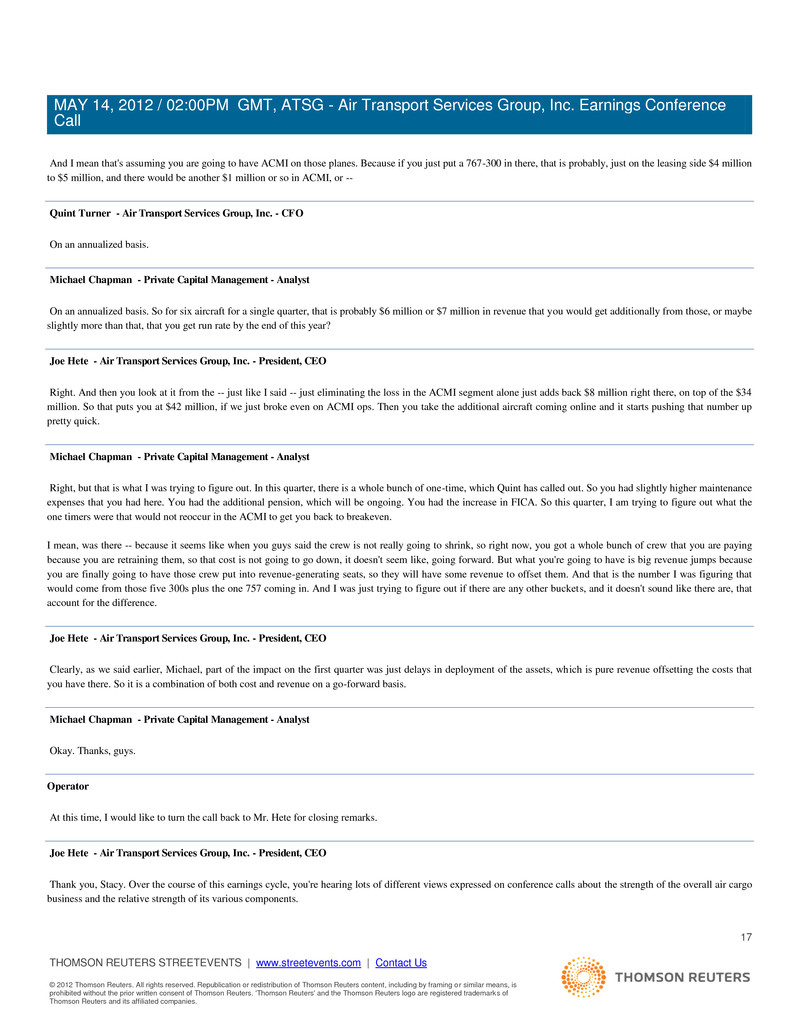
MAY 14, 2012 / 02:00PM GMT, ATSG - Air Transport Services Group, Inc. Earnings Conference Call 17 THOMSON REUTERS STREETEVENTS | www.streetevents.com | Contact Us © 2012 Thomson Reuters. All rights reserved. Republication or redistribution of Thomson Reuters content, including by framing or similar means, is prohibited without the prior written consent of Thomson Reuters. 'Thomson Reuters' and the Thomson Reuters logo are registered trademarks of Thomson Reuters and its affiliated companies. And I mean that's assuming you are going to have ACMI on those planes. Because if you just put a 767-300 in there, that is probably, just on the leasing side $4 million to $5 million, and there would be another $1 million or so in ACMI, or -- Quint Turner - Air Transport Services Group, Inc. - CFO On an annualized basis. Michael Chapman - Private Capital Management - Analyst On an annualized basis. So for six aircraft for a single quarter, that is probably $6 million or $7 million in revenue that you would get additionally from those, or maybe slightly more than that, that you get run rate by the end of this year? Joe Hete - Air Transport Services Group, Inc. - President, CEO Right. And then you look at it from the -- just like I said -- just eliminating the loss in the ACMI segment alone just adds back $8 million right there, on top of the $34 million. So that puts you at $42 million, if we just broke even on ACMI ops. Then you take the additional aircraft coming online and it starts pushing that number up pretty quick. Michael Chapman - Private Capital Management - Analyst Right, but that is what I was trying to figure out. In this quarter, there is a whole bunch of one-time, which Quint has called out. So you had slightly higher maintenance expenses that you had here. You had the additional pension, which will be ongoing. You had the increase in FICA. So this quarter, I am trying to figure out what the one timers were that would not reoccur in the ACMI to get you back to breakeven. I mean, was there -- because it seems like when you guys said the crew is not really going to shrink, so right now, you got a whole bunch of crew that you are paying because you are retraining them, so that cost is not going to go down, it doesn't seem like, going forward. But what you're going to have is big revenue jumps because you are finally going to have those crew put into revenue-generating seats, so they will have some revenue to offset them. And that is the number I was figuring that would come from those five 300s plus the one 757 coming in. And I was just trying to figure out if there are any other buckets, and it doesn't sound like there are, that account for the difference. Joe Hete - Air Transport Services Group, Inc. - President, CEO Clearly, as we said earlier, Michael, part of the impact on the first quarter was just delays in deployment of the assets, which is pure revenue offsetting the costs that you have there. So it is a combination of both cost and revenue on a go-forward basis. Michael Chapman - Private Capital Management - Analyst Okay. Thanks, guys. Operator At this time, I would like to turn the call back to Mr. Hete for closing remarks. Joe Hete - Air Transport Services Group, Inc. - President, CEO Thank you, Stacy. Over the course of this earnings cycle, you're hearing lots of different views expressed on conference calls about the strength of the overall air cargo business and the relative strength of its various components.
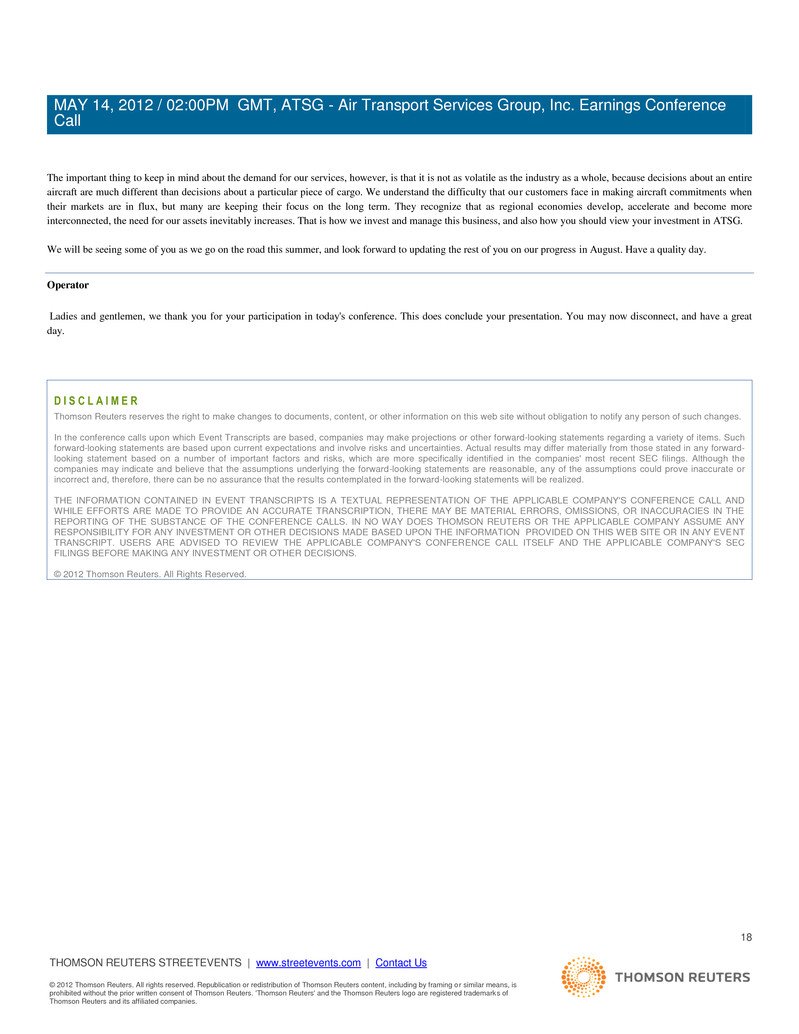
MAY 14, 2012 / 02:00PM GMT, ATSG - Air Transport Services Group, Inc. Earnings Conference Call 18 THOMSON REUTERS STREETEVENTS | www.streetevents.com | Contact Us © 2012 Thomson Reuters. All rights reserved. Republication or redistribution of Thomson Reuters content, including by framing or similar means, is prohibited without the prior written consent of Thomson Reuters. 'Thomson Reuters' and the Thomson Reuters logo are registered trademarks of Thomson Reuters and its affiliated companies. The important thing to keep in mind about the demand for our services, however, is that it is not as volatile as the industry as a whole, because decisions about an entire aircraft are much different than decisions about a particular piece of cargo. We understand the difficulty that our customers face in making aircraft commitments when their markets are in flux, but many are keeping their focus on the long term. They recognize that as regional economies develop, accelerate and become more interconnected, the need for our assets inevitably increases. That is how we invest and manage this business, and also how you should view your investment in ATSG. We will be seeing some of you as we go on the road this summer, and look forward to updating the rest of you on our progress in August. Have a quality day. Operator Ladies and gentlemen, we thank you for your participation in today's conference. This does conclude your presentation. You may now disconnect, and have a great day. D I S C L A I M E R Thomson Reuters reserves the right to make changes to documents, content, or other information on this web site without obligation to notify any person of such changes. In the conference calls upon which Event Transcripts are based, companies may make projections or other forward-looking statements regarding a variety of items. Such forward-looking statements are based upon current expectations and involve risks and uncertainties. Actual results may differ materially from those stated in any forward- looking statement based on a number of important factors and risks, which are more specifically identified in the companies' most recent SEC filings. Although the companies may indicate and believe that the assumptions underlying the forward-looking statements are reasonable, any of the assumptions could prove inaccurate or incorrect and, therefore, there can be no assurance that the results contemplated in the forward-looking statements will be realized. THE INFORMATION CONTAINED IN EVENT TRANSCRIPTS IS A TEXTUAL REPRESENTATION OF THE APPLICABLE COMPANY'S CONFERENCE CALL AND WHILE EFFORTS ARE MADE TO PROVIDE AN ACCURATE TRANSCRIPTION, THERE MAY BE MATERIAL ERRORS, OMISSIONS, OR INACCURACIES IN THE REPORTING OF THE SUBSTANCE OF THE CONFERENCE CALLS. IN NO WAY DOES THOMSON REUTERS OR THE APPLICABLE COMPANY ASSUME ANY RESPONSIBILITY FOR ANY INVESTMENT OR OTHER DECISIONS MADE BASED UPON THE INFORMATION PROVIDED ON THIS WEB SITE OR IN ANY EVENT TRANSCRIPT. USERS ARE ADVISED TO REVIEW THE APPLICABLE COMPANY'S CONFERENCE CALL ITSELF AND THE APPLICABLE COMPANY'S SEC FILINGS BEFORE MAKING ANY INVESTMENT OR OTHER DECISIONS. © 2012 Thomson Reuters. All Rights Reserved.
